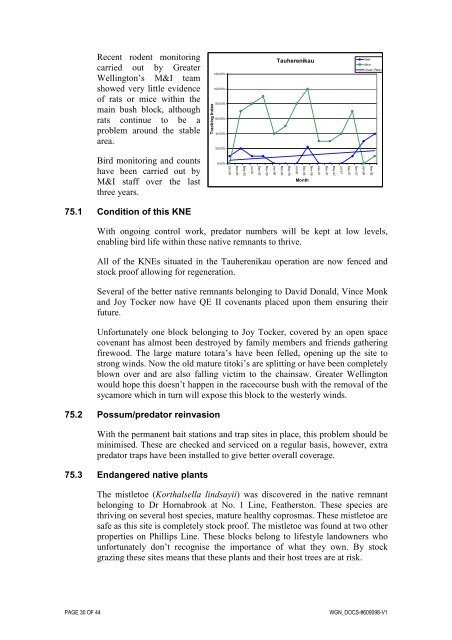Wairarapa Key Native Ecosystem Management Areas - Greater ...
Wairarapa Key Native Ecosystem Management Areas - Greater ...
Wairarapa Key Native Ecosystem Management Areas - Greater ...
Create successful ePaper yourself
Turn your PDF publications into a flip-book with our unique Google optimized e-Paper software.
Recent rodent monitoring<br />
carried out by <strong>Greater</strong><br />
Wellington’s M&I team<br />
showed very little evidence<br />
of rats or mice within the<br />
main bush block, although<br />
rats continue to be a<br />
problem around the stable<br />
area.<br />
Bird monitoring and counts<br />
have been carried out by<br />
M&I staff over the last<br />
three years.<br />
75.1 Condition of this KNE<br />
Tracking Index<br />
120.00%<br />
100.00%<br />
80.00%<br />
60.00%<br />
40.00%<br />
20.00%<br />
0.00%<br />
Tauherenikau<br />
PAGE 30 OF 44 WGN_DOCS-#609098-V1<br />
Jan-05<br />
Mar-05<br />
May-05<br />
Jul-05<br />
Sep-05<br />
Nov-05<br />
Jan-06<br />
Mar-06<br />
May-06<br />
Jul-06<br />
Sep-06<br />
Month<br />
Nov-06<br />
Jan-07<br />
Mar-07<br />
May-07<br />
Jul-07<br />
Sep-07<br />
Nov-07<br />
Jan-08<br />
Rats<br />
Mice<br />
Linear (Rats)<br />
With ongoing control work, predator numbers will be kept at low levels,<br />
enabling bird life within these native remnants to thrive.<br />
All of the KNEs situated in the Tauherenikau operation are now fenced and<br />
stock proof allowing for regeneration.<br />
Several of the better native remnants belonging to David Donald, Vince Monk<br />
and Joy Tocker now have QE II covenants placed upon them ensuring their<br />
future.<br />
Unfortunately one block belonging to Joy Tocker, covered by an open space<br />
covenant has almost been destroyed by family members and friends gathering<br />
firewood. The large mature totara’s have been felled, opening up the site to<br />
strong winds. Now the old mature titoki’s are splitting or have been completely<br />
blown over and are also falling victim to the chainsaw. <strong>Greater</strong> Wellington<br />
would hope this doesn’t happen in the racecourse bush with the removal of the<br />
sycamore which in turn will expose this block to the westerly winds.<br />
75.2 Possum/predator reinvasion<br />
With the permanent bait stations and trap sites in place, this problem should be<br />
minimised. These are checked and serviced on a regular basis, however, extra<br />
predator traps have been installed to give better overall coverage.<br />
75.3 Endangered native plants<br />
The mistletoe (Korthalsella lindsayii) was discovered in the native remnant<br />
belonging to Dr Hornabrook at No. 1 Line, Featherston. These species are<br />
thriving on several host species, mature healthy coprosmas. These mistletoe are<br />
safe as this site is completely stock proof. The mistletoe was found at two other<br />
properties on Phillips Line. These blocks belong to lifestyle landowners who<br />
unfortunately don’t recognise the importance of what they own. By stock<br />
grazing these sites means that these plants and their host trees are at risk.<br />
Mar-08
















